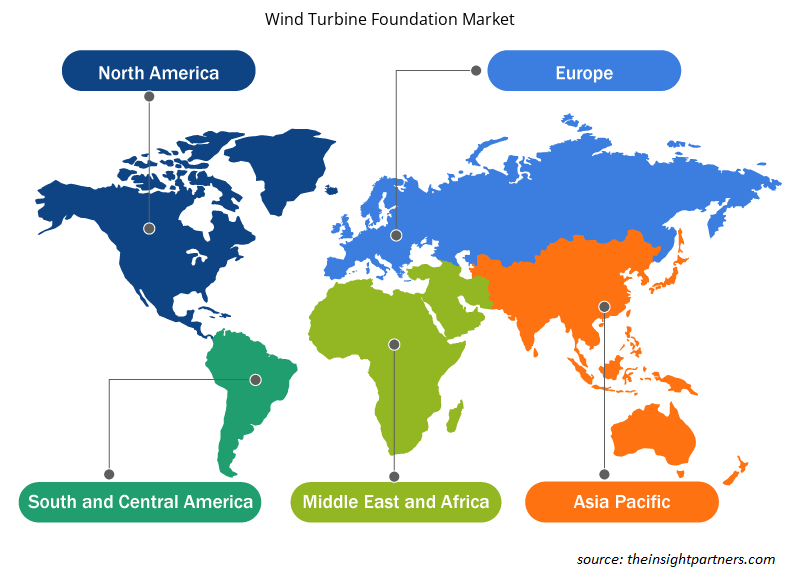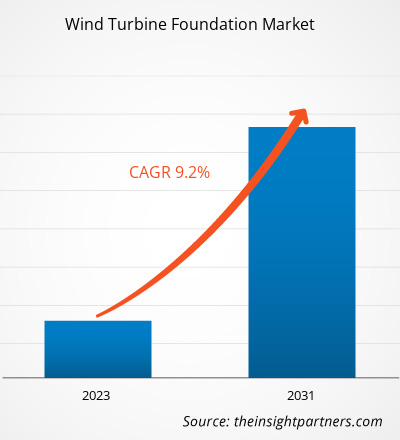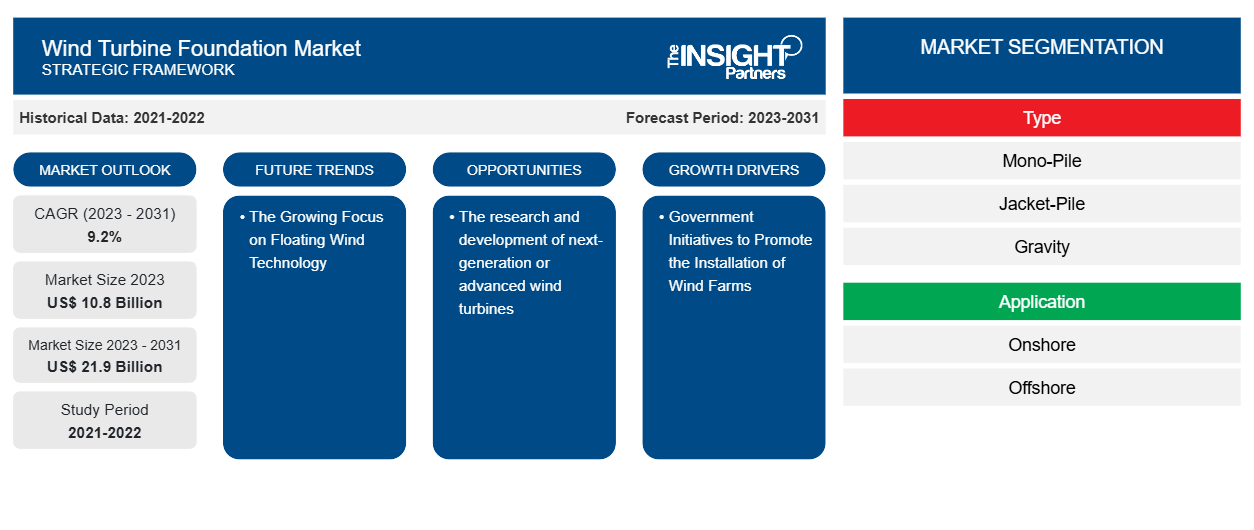Si prevede che la dimensione del mercato delle fondamenta delle turbine eoliche raggiungerà i 21,9 miliardi di dollari entro il 2031, rispetto ai 10,8 miliardi di dollari del 2023. Si prevede che il mercato registrerà un CAGR del 9,2% nel periodo 2023-2031. È probabile che la ricerca e lo sviluppo di turbine eoliche di nuova generazione o avanzate rimangano tendenze chiave nel mercato.
Analisi di mercato delle fondamenta delle turbine eoliche
Si prevede che il mercato delle fondamenta per turbine eoliche registrerà una crescita considerevole durante il periodo di tempo analizzato a causa del crescente numero di progetti di energia eolica onshore e offshore, in particolare in località remote. Inoltre, si prevede che le normative governative volte a ridurre le emissioni di carbonio concentrandosi sulla generazione di energia attraverso fonti di energia rinnovabili come vento, sole, geotermica e altre guideranno la crescita del mercato dal 2023 al 2031. Inoltre, si prevede che le iniziative governative volte all'installazione di parchi eolici in tutto il mondo alimenteranno la crescita del mercato nei prossimi anni.
Panoramica del mercato delle fondamenta delle turbine eoliche
Con l'aumento della popolazione e dell'industrializzazione, la domanda di energia sta aumentando anche a livello globale. L'aumento del consumo di energia ha anche aumentato la necessità di generazione di energia rinnovabile nelle economie in via di sviluppo e sviluppate. Ciò ha portato a un aumento della domanda di infrastrutture per l'energia eolica in tutto il mondo. La generazione di energia eolica ha acquisito un elevato livello di importanza e accettabilità in tutto il mondo rispetto ad altre fonti di energia rinnovabile. Gli sviluppi avanzati nella tecnologia nella progettazione e nello sviluppo di pale eoliche, turbine, fondamenta, alberi e altri componenti hanno contribuito a un significativo progresso nell'adozione dell'energia eolica e nel raggiungimento della massima potenza dal vento disponibile. Secondo l'Agenzia internazionale per le energie rinnovabili (IRENA), la capacità eolica installata a livello globale ha raggiunto 1.017 GW entro la fine del 2023 dagli 825 GW del 2021.
Pertanto, si prevede che un tale aumento della capacità eolica installata aumenterà nei prossimi anni, grazie ai vantaggi dell'energia eolica e alle politiche favorevoli, agli incentivi e agli sgravi fiscali. Si prevede che un tale aumento della capacità di installazione eolica in tutto il mondo sarà il motore principale del mercato delle fondamenta delle turbine eoliche.
Personalizza questo report in base alle tue esigenze
Riceverai la personalizzazione gratuita di qualsiasi report, comprese parti di questo report, o analisi a livello nazionale, pacchetto dati Excel, oltre a usufruire di grandi offerte e sconti per start-up e università
-
Scopri le principali tendenze di mercato in questo rapporto.Questo campione GRATUITO includerà analisi di dati che spaziano dalle tendenze di mercato alle stime e alle previsioni.
Driver e opportunità del mercato delle fondazioni per turbine eoliche
Iniziative governative per promuovere l'installazione di parchi eolici a favore del mercato
Si prevede che un aumento del supporto da parte di vari governi di diversi paesi in termini di politiche, sussidi e investimenti per aumentare l'installazione di progetti di energia eolica alimenterà la crescita del mercato delle fondamenta delle turbine eoliche nel periodo di tempo analizzato. Il governo indiano è impegnato nella promozione di impianti eolici nel paese attraverso finanziamenti del settore privato, fornendo vari incentivi fiscali e finanziari come i benefici dell'ammortamento accelerato e dazi doganali agevolati o esenzioni fiscali su determinati componenti dei generatori eolici. Ad esempio, la Germania sta pianificando di introdurre una proposta di legge per accelerare l'espansione dell'energia eolica. La nuova legge applicherà obiettivi di area vincolanti per l'espansione dell'energia eolica onshore negli stati federali. Ad aprile 2022, la Germania ha pianificato di implementare obiettivi eolici offshore a oltre 10 GW all'anno a partire dal 2025 con l'aiuto di un pacchetto storico chiamato Pacchetto di Pasqua, che è la serie più profonda di cambiamenti nella politica energetica tedesca. Con l'aiuto di queste iniziative governative, l'80% della domanda di elettricità della Germania sarà coperta da elettricità da fonti energetiche rinnovabili entro il 2030.
La crescente attenzione alla tecnologia eolica galleggiante
La tecnologia eolica galleggiante è la turbina eolica offshore montata su una struttura galleggiante nel mare che assicura che la turbina generi elettricità in profondità nell'acqua. La tecnologia eolica galleggiante o offshore è altamente efficiente in condizioni ambientali difficili e quindi in grado di produrre enormi quantità di energia. Questa tecnologia eolica galleggiante è adottata a livello globale in vari paesi come Cina, Germania, Giappone, Regno Unito, Francia, Belgio e Danimarca. Le prospettive di crescita nell'adozione della tecnologia eolica galleggiante sono principalmente attribuite a un aumento dell'avanzamento della tecnologia, ai vantaggi associati e alle soluzioni chiavi in mano fornite da vari fornitori di servizi. La crescente consapevolezza per il raggiungimento di obiettivi di energia pulita da parte di vari paesi sta spingendo la domanda di energia eolica offshore galleggiante, che sta rappresentando una potenziale opportunità per la crescita del mercato delle fondamenta delle turbine eoliche.
Il rapporto Floating Offshore Wind Centre of Excellence ha individuato 22 paesi che sono più pronti a diventare attori principali nella nascente tecnologia delle energie rinnovabili. A gennaio 2022, il governo del Regno Unito ha annunciato 11 progetti di energia rinnovabile che riceveranno ciascuno fino a 959,23 milioni di dollari USA, in quanto stanzia 2,97 miliardi di dollari USA per incrementare l'energia rinnovabile generata nel Regno Unito. Si prevede che tali investimenti nella tecnologia eolica offshore o galleggiante in tutto il mondo alimenteranno la crescita del mercato nei prossimi anni.
Analisi della segmentazione del rapporto di mercato delle fondamenta delle turbine eoliche
I segmenti chiave che hanno contribuito alla derivazione dell'analisi di mercato delle fondazioni per turbine eoliche sono tipologia e applicazione.
- In base al tipo, il mercato delle fondazioni per turbine eoliche è suddiviso in mono-palo, jacket-palo, gravità, tripode, aspirazione, zattera, palo, fondazione per pozzi, roccia e ancoraggio e altri. Il segmento gravità ha detenuto una quota di mercato maggiore nel 2023.
- In base all'applicazione, il mercato è segmentato in onshore e offshore. Il segmento onshore ha detenuto una quota di mercato maggiore nel 2023.
Analisi della quota di mercato delle fondazioni per turbine eoliche per area geografica
L'ambito geografico del rapporto sul mercato delle fondazioni per turbine eoliche è suddiviso principalmente in cinque regioni: Nord America, Asia Pacifico, Europa, Medio Oriente e Africa, e Sud e Centro America.
L'Asia Pacifico ha dominato il mercato delle fondazioni per turbine eoliche nel 2023. La regione Asia Pacifico comprende Cina, Australia, India, Corea del Sud, Giappone e il resto dell'Asia Pacifico. L'Asia Pacifico ha rappresentato la quota di mercato maggiore nel mercato globale delle fondazioni per turbine eoliche nel 2023 e si prevede che si espanderà al CAGR più rapido durante il periodo di previsione. La solida industria onshore e la presenza di un gran numero di produttori di fondazioni per turbine eoliche nell'area sono responsabili dell'elevata quota di mercato. Inoltre, l'espansione del settore offshore in Cina, Giappone, Corea del Sud e Asia sud-orientale sta stimolando il mercato dei fornitori di fondazioni per turbine eoliche in tutta la regione. Inoltre, si prevede che un aumento degli investimenti per l'installazione di parchi eolici onshore e offshore nella regione stimolerà la domanda di fondazioni per turbine eoliche nei prossimi anni.
Approfondimenti regionali sul mercato delle fondazioni per turbine eoliche
Le tendenze regionali e i fattori che influenzano il mercato delle fondazioni per turbine eoliche durante il periodo di previsione sono stati ampiamente spiegati dagli analisti di Insight Partners. Questa sezione discute anche i segmenti e la geografia del mercato delle fondazioni per turbine eoliche in Nord America, Europa, Asia Pacifico, Medio Oriente e Africa e Sud e Centro America.

- Ottieni i dati specifici regionali per il mercato delle fondamenta delle turbine eoliche
Ambito del rapporto di mercato sulle fondamenta delle turbine eoliche
| Attributo del report | Dettagli |
|---|---|
| Dimensioni del mercato nel 2023 | 10,8 miliardi di dollari USA |
| Dimensioni del mercato entro il 2031 | 21,9 miliardi di dollari USA |
| CAGR globale (2023-2031) | 9,2% |
| Dati storici | 2021-2022 |
| Periodo di previsione | 2023-2031 |
| Segmenti coperti |
Per tipo
|
| Regioni e Paesi coperti |
America del Nord
|
| Leader di mercato e profili aziendali chiave |
|
Densità degli attori del mercato delle fondazioni per turbine eoliche: comprendere il suo impatto sulle dinamiche aziendali
Il mercato del Wind Turbine Foundation Market sta crescendo rapidamente, spinto dalla crescente domanda degli utenti finali dovuta a fattori quali l'evoluzione delle preferenze dei consumatori, i progressi tecnologici e una maggiore consapevolezza dei vantaggi del prodotto. Con l'aumento della domanda, le aziende stanno ampliando le loro offerte, innovando per soddisfare le esigenze dei consumatori e capitalizzando sulle tendenze emergenti, il che alimenta ulteriormente la crescita del mercato.
La densità degli operatori di mercato si riferisce alla distribuzione di aziende o società che operano in un particolare mercato o settore. Indica quanti concorrenti (operatori di mercato) sono presenti in un dato spazio di mercato in relazione alle sue dimensioni o al valore di mercato totale.
Le principali aziende che operano nel mercato delle fondazioni per turbine eoliche sono:
- Fuga
- Gruppo Ramboll A/S
- Iberdrola SA
- BW Ideale
- Gruppo Peikko
- Gruppo EEW
Disclaimer : le aziende elencate sopra non sono classificate secondo un ordine particolare.

- Ottieni una panoramica dei principali attori del mercato delle fondazioni per turbine eoliche
Notizie di mercato e sviluppi recenti sulle fondazioni delle turbine eoliche
Il mercato delle fondamenta per turbine eoliche viene valutato raccogliendo dati qualitativi e quantitativi dopo la ricerca primaria e secondaria, che include importanti pubblicazioni aziendali, dati associativi e database. Di seguito sono elencati alcuni degli sviluppi nel mercato delle fondamenta per turbine eoliche:
- Odfjell Oceanwind ha collaborato con Prodtex. Questa collaborazione mirava ad aumentare la capacità produttiva delle fondamenta eoliche galleggianti con l'obiettivo di aprire la struttura entro il 2027. (Fonte: Odfjell Oceanwind, comunicato stampa, febbraio 2024)
- Principle Power ha lanciato una nuova fondazione eolica galleggiante a pannello piatto, basata su pontoni, denominata WindFloat F. Questa fondazione è progettata per l'integrazione di turbine eoliche ultra-superficiali nei porti (Fonte: Principle Power, comunicato stampa, settembre 2023)
Copertura e risultati del rapporto di mercato sulle fondazioni delle turbine eoliche
Il rapporto "Wind Turbine Foundation Market Size and Forecast (2021–2031)" fornisce un'analisi dettagliata del mercato che copre le seguenti aree:
- Dimensioni e previsioni del mercato delle fondamenta delle turbine eoliche a livello globale, regionale e nazionale per tutti i principali segmenti di mercato coperti dall'ambito
- Tendenze del mercato delle fondamenta delle turbine eoliche e dinamiche di mercato come driver, vincoli e opportunità chiave
- Analisi PEST e SWOT dettagliate
- Analisi di mercato delle fondamenta delle turbine eoliche che copre le principali tendenze del mercato, il quadro globale e regionale, i principali attori, le normative e i recenti sviluppi del mercato
- Analisi del panorama industriale e della concorrenza che copre la concentrazione del mercato, l'analisi della mappa di calore, i principali attori e gli sviluppi recenti per il mercato delle fondamenta delle turbine eoliche
- Profili aziendali dettagliati
- Analisi storica (2 anni), anno base, previsione (7 anni) con CAGR
- Analisi PEST e SWOT
- Valore/volume delle dimensioni del mercato - Globale, Regionale, Nazionale
- Industria e panorama competitivo
- Set di dati Excel
Report recenti
Rapporti correlati
Testimonianze
Motivo dell'acquisto
- Processo decisionale informato
- Comprensione delle dinamiche di mercato
- Analisi competitiva
- Analisi dei clienti
- Previsioni di mercato
- Mitigazione del rischio
- Pianificazione strategica
- Giustificazione degli investimenti
- Identificazione dei mercati emergenti
- Miglioramento delle strategie di marketing
- Aumento dell'efficienza operativa
- Allineamento alle tendenze normative























 Ottieni un campione gratuito per - Mercato delle fondazioni per turbine eoliche
Ottieni un campione gratuito per - Mercato delle fondazioni per turbine eoliche